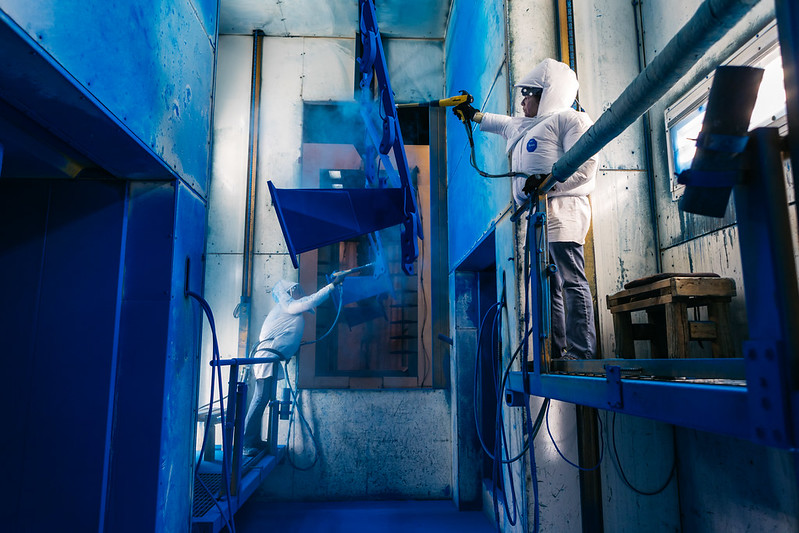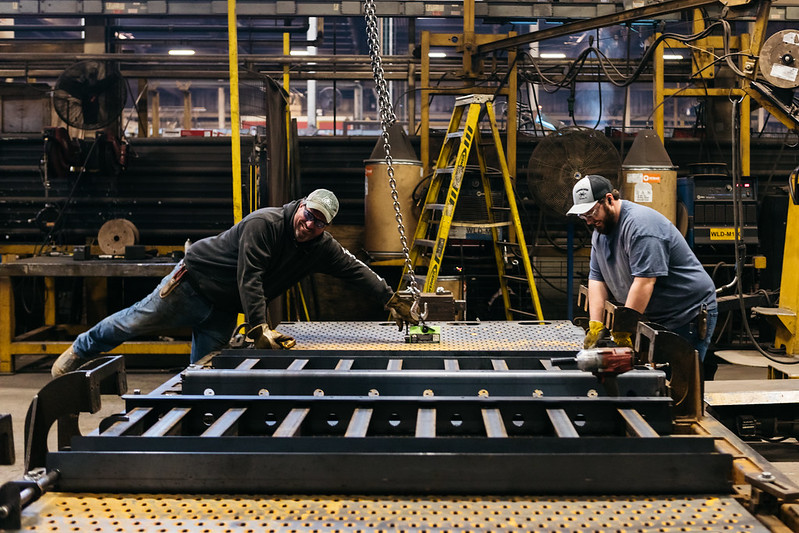In celebrating National Agriculture Week and National Ag Day, AEM recognizes the importance of agriculture and the role it plays in our society. What’s more, we applaud the role of farmers in helping our members develop the equipment making it possible for food to get from the fields to our tables. Learn more.
Milk is the cornerstone of not only a healthy diet, but also a healthy segment of the economy.
According to data from the International Dairy Foods Association (IDFA), the U.S. dairy industry helps generate 3.3 million jobs, more GDP than the auto industry, and billions of dollars in federal, state, and local taxes. None of it would be possible if not for the American dairy farmer.
Interestingly, dairy farms have been under considerable pressure for many years. The work they do is often mischaracterized as inefficient, inhumane, and environmentally adverse, none of which is true.
The number of U.S. dairy farms has also continued to dwindle. In fact, U.S. dairy farm attrition has been averaging roughly 8-12% per year, according to Fernando Cuccioli, Executive Vice President at AEM member company DeLaval.
“When I started in the milking equipment business in 1986, the number of dairy farms was approximately 150,000,” added Steve Pretz, President of AEM member company BouMatic. “Now there are only around 30,000 businesses milking cows today.”
But that hasn’t resulted in a loss of production, nor has it led to a rise in unsustainable farming practices. Pretz said he believes this is the biggest untold story in all of agriculture.
“Back in 1986, average production per cow per year was around 11,500 lbs.,” Pretz said. “Now, the average is closer to 23,000. Over that same period, the population of cows being milked has declined from 14 million to 9 million. But despite that, yield has nearly doubled. So, in order to produce a pound of milk, carbon footprint has been reduced by more than 70% over the course of my 36-year career. I’m not sure any other segment of agriculture can come anywhere close to that, here or anywhere else in the world.”
AEM’s report, “Environmental Benefits of Modern Dairy, Hay, and Forage Production Technologies,” highlights several statistics that help quantify the positive impact of modern dairy practices in the U.S. and Canada. For instance, milk yield increased 350% from 1960 to 2020 in North America. During that same timeframe, yield increased just 150% throughout the rest of the world.
Much of the improvements seen in North America has taken place in more recent years. From 2007 through 2021:
- Yield per cow has increased 19%
- Feed usage is down 15%
- Land use is down 26%
- GHG emissions are down 17%
- Water use is down 10%
“It’s really unbelievable,” Cuccioli said. “Year after year, the U.S. dairy industry seems to get even better. We’re gaining 1-3% productivity every year. And it’s not one single thing that allows for that kind of improvement. The secret is that it happens through a very holistic approach coming from years of multigenerational experience.”
“In order to produce a pound of milk, carbon footprint has been reduced by more than 70% over the course of my 36-year career. I’m not sure any other segment of agriculture can come anywhere close to that, here or anywhere else in the world.” -- BouMatic's Steve Pretz
Multigenerational, Free-Market Ingenuity
Each generation of dairy farmers has continued to take what they’ve learned, apply new tools and concepts, and continue advancing the industry. Yes, technological advancements like sensors, automation, robotics, and data play a big role in that. But other factors play a role, too, including genetics, farm management practices, animal care, vaccines, and feed additives.
“When you put all of those things together and keep making them better, that’s where you can really make a difference,” Cuccioli said.
That holistic approach has been making a difference in North America, a continent that produces roughly 15% of the world’s milk with just 4% of the cows. That is only possible because North American dairy cows produce four times as much milk as the global average.
Pretz said certain European markets have also seen meaningful gains in dairy production, though he wouldn’t compare them to what the U.S. and Canada have achieved. New Zealand has also become a strong influencer in milk production. However, New Zealand’s dairy cow population is largely grass-fed, which limits how much milk a given cow can produce.
“Here in the U.S., higher-density feed intake, genetic gain, and high-intensity agriculture have been the secret,” Pretz said. “A lot of that has been free-market pressure. There have never been supply chain management or milk production quotas over a sustained period of time. Capitalistic forces have been driving the improvements, almost by accident. Commercialization has made all of this possible.”
The question now is: What are the possibilities over the next several decades?
The Economic Opportunity for U.S. Dairy
Domestic demand for U.S. dairy products is expected to remain strong for years to come. As liquid milk consumption dips, other products like cheese, ice cream and yogurt will continue to fill the gap.
“The dairy industry needs to be creative and cater to the evolving tastes of today’s consumer,” said Cuccioli. “Effective packaging, marketing and education will also help.”
The U.S. dairy industry’s biggest opportunity could be on the export side. As Pretz pointed out, the U.S. has become a reliable exporter of dairy products, including milk, for the first time in history.
“Anybody who has been in this industry a long time will tell you that U.S. dairies have been opportunistic exporters,” Pretz said. “When we have a bunch in storage, we become eager to sell it at a low price on the market. That has changed. The U.S. now has the most modern milk powder plants on the planet. The U.S. now exports the highest-quality milk powder products on a very consistent basis.”
Cuccioli has also been encouraged by the emerging economic opportunity in exports. He said exports have been hovering in the 15% range. That’s a big jump from less than 6% just 15 years ago. Going forward, Cuccioli wouldn’t be surprised to see dairy exports shoot past 20%.
“North America, and also Latin America to some extent, have a great opportunity,” Cuccioli said. “We have the resources—the land, water, feed, and knowledge. That’s not the case in other places around the world. For example, Europe is going through significant change from a sustainability standpoint. Europe doesn’t have the space for dairy farming like North America does. We do have sustainability pressures here in the U.S. But we’re responding by using new technologies to keep up. That’s why I believe we will really become an export machine and gain even more share of the global dairy market in coming years.”
In the longer-term, perhaps 60 years from now when the population could begin to decline, the U.S. dairy industry will be well-positioned to capitalize on shifting market dynamics. As population declines, average income climbs, and more people begin demanding safer, higher-quality food products—something the U.S. and North America are well-respected for. “For the U.S. dairy industry in particular, this is the opportunity of a generation moving forward,” Pretz said.
In the nearer term, it’s about helping feed a population that continues to grow. Pretz said he is a big believer in the idea that high-quality, low-cost food is for everyone. This is where the U.S. approach differs from many other parts of the world.
“In Canada, for instance, they have supply management which works for them,” Pretz explained. “They also have one of the three highest milk prices to the farmer in the world. But that does nothing for the person in Cambodia or somewhere in Africa who is trying to feed their family on what might be $2,000 in annual income. The availability of high-quality animal protein that’s safe and affordable is my personal passion. This is where the U.S. has the opportunity to outshine everybody. Good old-fashioned market forces will continue to drive the constant push for better, cheaper, and faster, every single day.”
“We do have sustainability pressures here in the U.S. But we’re responding by using new technologies to keep up. That’s why I believe we will really become an export machine and gain even more share of the global dairy market in coming years.” -- DeLaval's Fernando Cuccioli
As yet another generation of U.S. dairy farmers begins to assume their leadership positions in the years ahead, Cuccioli is confident that the impressive momentum generated over the past 15 years will continue. Through further genetic improvements and a more widespread adoption of technology, some equally impressive gains could be realized over the next eight years:
- Milk yield could increase another 11%, 3% due to technology alone
- Feed use could be reduced by another 19%, 6% due to technology alone
- Land use could be reduced by another 9%, 4% due to technology alone
- GHG emissions could be reduced by another 19%, 8% due to technology alone
- Water use could be reduced by another 4%, 3% due to technology alone
“The U.S. is considered the benchmark around the world when it comes to productivity and sustainability,” Cuccioli noted. “I can’t help but think that as more of the industry adopts these new technologies, the benefits will only multiply greater and greater. New technologies will not only help attract and retain the future generation of dairy farmers, but will also allow the industry to be even more productive than it already is today.”
That is why North American milk is poised to remain a model of sustainability for the world.
The Association of Equipment Manufacturers (AEM), The National Milk Producers Federation and Dairy Farmers of America, issued a study quantifying the benefits of modern dairy technologies and how they have positively impacted consumers, dairy farmers and cows over the past 15 years.
The study was unveiled at World Dairy Expo in Madison, Wisconsin.
For more AEM member perspectives, subscribe to the AEM Industry Advisor.





